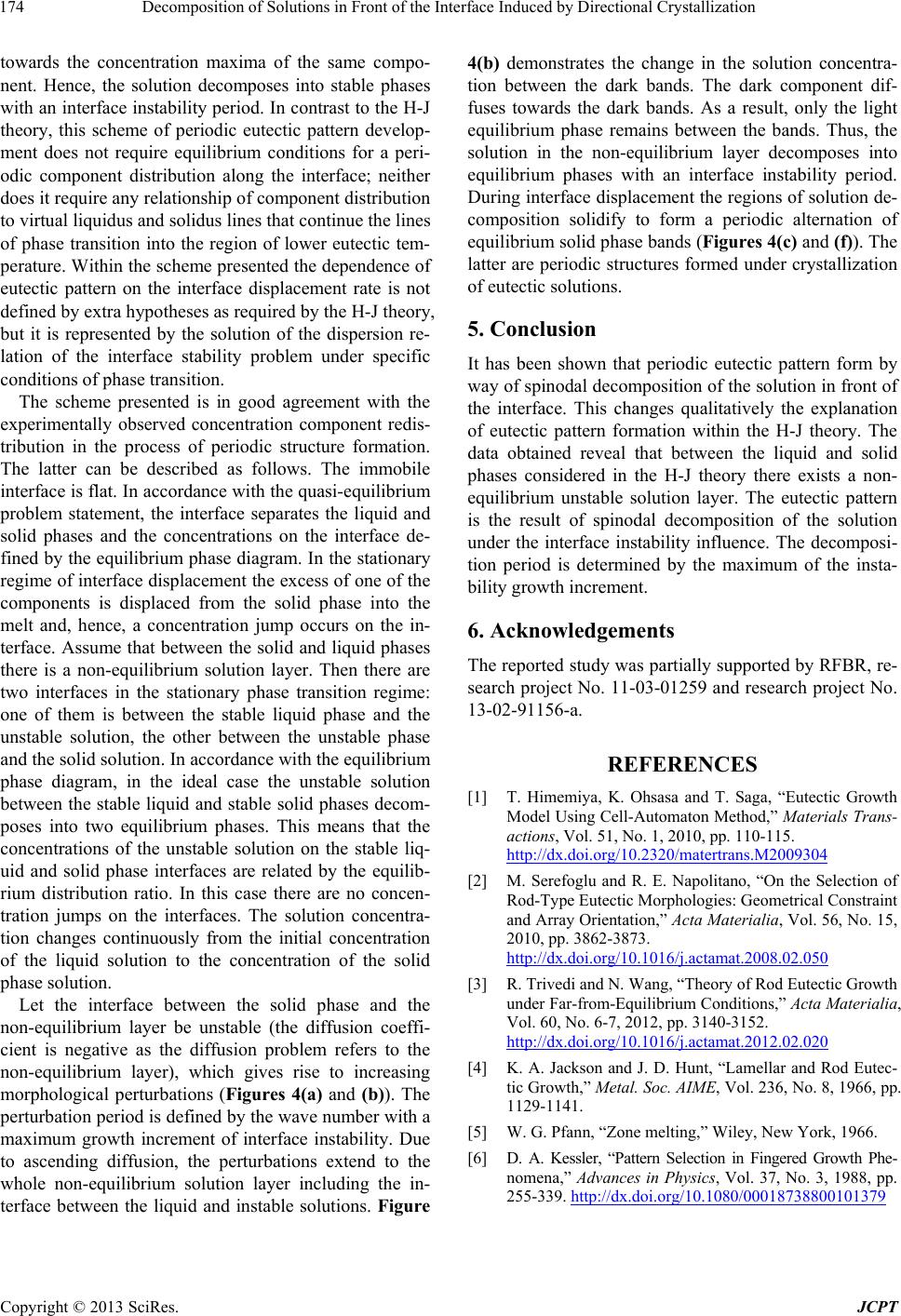
Decomposition of Solutions in Front of the Interface Induced by Directional Crystallization
Copyright © 2013 SciRes. JCPT
174
towards the concentration maxima of the same compo-
nent. Hence, the solution decomposes into stable phases
with an interface instab ility period. In contrast to the H-J
theory, this scheme of periodic eutectic pattern develop-
ment does not require equilibrium conditions for a peri-
odic component distribution along the interface; neither
does it require any relationship of component distribution
to virtual liquidus and solidus lines that continue the lines
of phase transition into the region of lower eutectic tem-
perature. Within the scheme presented the dependence of
eutectic pattern on the interface displacement rate is not
defined by extra hypotheses as required by the H-J theory,
but it is represented by the solution of the dispersion re-
lation of the interface stability problem under specific
conditions of phase transition.
The scheme presented is in good agreement with the
experimentally observed concentration component redis-
tribution in the process of periodic structure formation.
The latter can be described as follows. The immobile
interface is flat. In accordance with the quasi-equilibrium
problem statement, the interface separates the liquid and
solid phases and the concentrations on the interface de-
fined by the equilibrium phase diagram. In the statio nary
regime of interface displacement the excess of one of the
components is displaced from the solid phase into the
melt and, hence, a concentration jump occurs on the in-
terface. Assume that between the solid and liquid phases
there is a non-equilibrium solution layer. Then there are
two interfaces in the stationary phase transition regime:
one of them is between the stable liquid phase and the
unstable solution, the other between the unstable phase
and the solid solution. In accordance with the equilibrium
phase diagram, in the ideal case the unstable solution
between the stable liquid and stable solid phases decom-
poses into two equilibrium phases. This means that the
concentrations of the unstable solution on the stable liq-
uid and solid phase interfaces are related by the equilib-
rium distribution ratio. In this case there are no concen-
tration jumps on the interfaces. The solution concentra-
tion changes continuously from the initial concentration
of the liquid solution to the concentration of the solid
phase solution.
Let the interface between the solid phase and the
non-equilibrium layer be unstable (the diffusion coeffi-
cient is negative as the diffusion problem refers to the
non-equilibrium layer), which gives rise to increasing
morphological perturbations (Figures 4(a) and (b)). The
perturbation period is defined by the wave number with a
maximum growth increment of interface instability. Due
to ascending diffusion, the perturbations extend to the
whole non-equilibrium solution layer including the in-
terface between the liquid and instable solutions. Figure
4(b) demonstrates the change in the solution concentra-
tion between the dark bands. The dark component dif-
fuses towards the dark bands. As a result, only the light
equilibrium phase remains between the bands. Thus, the
solution in the non-equilibrium layer decomposes into
equilibrium phases with an interface instability period.
During interface displacement the regions of solution de-
composition solidify to form a periodic alternation of
equilibrium solid phase bands (Figures 4(c) and (f)). The
latter are periodic structures formed under crystallization
of eutectic solutions.
5. Conclusion
It has been shown that periodic eutectic pattern form by
way of spinodal decomposition of the solution in front of
the interface. This changes qualitatively the explanation
of eutectic pattern formation within the H-J theory. The
data obtained reveal that between the liquid and solid
phases considered in the H-J theory there exists a non-
equilibrium unstable solution layer. The eutectic pattern
is the result of spinodal decomposition of the solution
under the interface instability influence. The decomposi-
tion period is determined by the maximum of the insta-
bility growth increment.
6. Acknowledgements
The reported study was partially supported by RFBR, re-
search project No. 11-03 -01259 and research proj ect No.
13-02-91156-a.
REFERENCES
[1] T. Himemiya, K. Ohsasa and T. Saga, “Eutectic Growth
Model Using Cell-Automaton Method,” Materials Trans-
actions, Vol. 51, No. 1, 2010, pp. 110-115.
http://dx.doi.org/10.2320/matertrans.M2009304
[2] M. Serefoglu and R. E. Napolitano, “On the Selection of
Rod-Type Eutectic Morphologies: Geometrical Constraint
and Array Orienta tion, ” Acta Materialia, Vol. 56, No. 15,
2010, pp. 3862-3873.
http://dx.doi.org/10.1016/j.actamat.2008.02.050
[3] R. Trivedi and N. Wang, “Theory of Rod Eutectic Growth
under Far-from-Equilibrium Conditions,” Acta Materialia,
Vol. 60, No. 6-7, 2012, pp. 3140-3152.
http://dx.doi.org/10.1016/j.actamat.2012.02.020
[4] K. A. Jackson and J. D. Hunt, “Lamellar and Rod Eutec-
tic Growth,” Metal. Soc. AIME, Vol. 236, No. 8, 1966, pp.
1129-1141.
[5] W. G. Pfann, “Zone melting,” Wiley, New York, 1966.
[6] D. A. Kessler, “Pattern Selection in Fingered Growth Phe-
nomena,” Advances in Physics, Vol. 37, No. 3, 1988, pp.
255-339. http://dx.doi.org/10.1080/00018738800101379